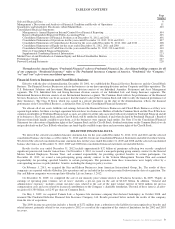Prudential 2012 Annual Report Download - page 20
Download and view the complete annual report
Please find page 20 of the 2012 Prudential annual report below. You can navigate through the pages in the report by either clicking on the pages listed below, or by using the keyword search tool below to find specific information within the annual report.We include the impact of the embedded derivatives associated with certain of the optional living benefit features of our variable annuity
contracts and related hedging activities in actual gross profits used as the basis for calculating current period amortization. We include only
certain of these impacts in our best estimate of gross profits used to determine DAC and DSI amortization rates. Beginning in 2012, we
include the difference between the change in the fair value of hedge positions and the change in the value of an internally-defined hedge
target in our best estimate of total gross profits used for determining amortization rates each quarter, without regard to the permanence of the
changes. In 2011 and the second half of 2010, we included these impacts only to the extent this net amount was determined by management
to be other-than-temporary. Prior to changing our hedging strategy to incorporate the internally-defined hedge target in the second half of
2010, we considered the change in the fair value of hedge positions and the change in the embedded derivative liability as defined under
U.S. GAAP, excluding the impact of the market-perceived risk of our own non-performance, each quarter in determining amortization rates.
These changes over time reflect our regular review of the estimated profitability of our business, changes in our hedging strategy and other
factors. For additional information on our internally-defined hedge target, as well as the current period impact of resetting amortization rates
for this activity, see “—Results of Operations for Financial Services Businesses by Segment—U.S. Retirement Solutions and Investment
Management Division—Individual Annuities—Variable Annuity Living Benefits Hedging Program Results.”
Annual assumptions review and quarterly adjustments
Annually, during the third quarter, we perform a comprehensive review of the assumptions used in estimating gross profits for future
periods. Although we review these assumptions on an ongoing basis throughout the year, we generally only update these assumptions and
adjust the DAC and DSI balances during the third quarter, unless a material change that we feel is indicative of a long term trend is
observed in an interim period. Over the last several years, the Company’s most significant assumption updates resulting in a change to
expected future gross profits and the amortization of DAC and DSI have been related to lapse experience and other contractholder behavior
assumptions, mortality, and revisions to expected future rates of returns on investments. We expect these assumptions to be the ones most
likely to cause potential significant changes in the future. The impact on our results of operations of changes in these assumptions can be
offsetting and we are unable to predict their movement or offsetting impact over time.
The quarterly adjustments for current period experience referred to above reflect the impact of differences between actual gross profits
for a given period and the previously estimated expected gross profits for that period. To the extent each period’s actual experience differs
from the previous estimate for that period, the assumed level of total gross profits may change. In these cases, we recognize a cumulative
adjustment to all previous periods’ amortization, also referred to as an experience true-up adjustment.
The quarterly adjustments for market performance referred to above reflect the impact of changes to our estimate of total gross profits
to reflect actual fund performance. A significant portion of gross profits for our variable annuity contracts and, to a lesser degree, our
variable life policies are dependent upon the total rate of return on assets held in separate account investment options. This rate of return
influences the fees we earn, costs we incur associated with the guaranteed minimum death and guaranteed minimum income benefit
features related to our variable annuity contracts, as well as other sources of profit. Returns that are higher than our expectations for a given
period produce higher than expected account balances, which increase the future fees we expect to earn and decrease the future costs we
expect to incur associated with the guaranteed minimum death and guaranteed minimum income benefit features related to our variable
annuity contracts. The opposite occurs when returns are lower than our expectations. The changes in future expected gross profits are used
to recognize a cumulative adjustment to all prior periods’ amortization.
The near-term future rate of return assumptions used in evaluating DAC and DSI for our domestic variable annuity and variable life
insurance products are derived using a reversion to the mean approach, a common industry practice. Under this approach, we consider the
actual historical economic returns over a period of time and initially adjust future projected returns over the next four years (the “near-
term”) so that the assets are projected to grow at the long-term expected rate of return for the entire period. If the near-term projected future
rate of return is greater than our near-term maximum future rate of return, we use our maximum future rate of return.
The weighted average rate of return assumptions for these businesses consider many factors specific to each business, including asset
durations, asset allocations and other factors. We update the near term rates of return and our estimate of total gross profits each quarter to
reflect the result of the reversion to the mean approach, which assumes a convergence to the long-term expected rates of return. These
market performance related adjustments to our estimate of total gross profits result in cumulative adjustments to prior amortization,
reflecting the application of the new required rate of amortization to all prior periods’ gross profits. The new required rate of amortization
is also applied prospectively to future gross profits in calculating amortization in future periods.
As of December 31, 2012, our variable annuities business utilizes distinct rates of return for equity and fixed income investments.
Assumptions for this business reflect an 8.0% long-term equity expected rate of return and a near-term mean reversion equity rate of return of
9.1%. As of December 31, 2012, all contract groups within our variable annuities business utilized these rates, as the near-term mean
reversion equity rate of return was less than our 13% maximum. Fixed income expected rates of return include a risk-free return plus a credit
spread and consider the duration and credit profile of the respective bond funds. Fixed income returns reflect a grading from current rates up
to long term rates over a ten year period. The weighted average fixed income expected rate of return after the ten year grading period is 5.4%.
As of December 31, 2012, our variable life insurance business utilizes blended rates of return, which are based on a long-term
expected distribution of funds between equity and fixed income funds. Assumptions for this business reflect a long-term blended expected
rate of return of 6.5%, which includes an 8.1% long-term equity expected rate of return and a 4.5% fixed income expected rate of return.
The 4.5% fixed income expected rate of return is a levelized rate, which blends current rates and long-term expected returns. Assumptions
also reflect a near-term mean reversion blended rate of return of 5.9%. As of December 31, 2012, all contract groups within our variable
life insurance business utilize these rates, as the near-term equity rate of return was less than our 13% maximum.
18 Prudential Financial, Inc. 2012 Annual Report
























